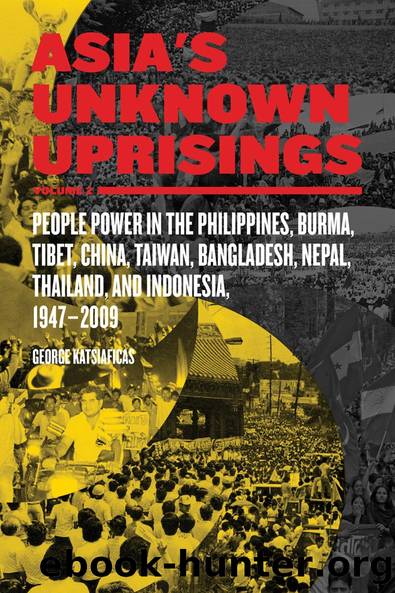Asia's Unknown Uprisings Volume 2 by George Katsiaficas

Author:George Katsiaficas [Katsiaficas, George]
Language: eng
Format: epub
Tags: History, Asia, General, Political Science, World, Asian
ISBN: 9781604868562
Google: YbVHEAAAQBAJ
Publisher: PM Press
Published: 2013-04-01T04:09:13+00:00
Jana Andolan 2âThe 2006 Loktantra Andolan
On April 6, exactly sixteen years after the first jana andolan according to the Nepali Calendar, the leadership of the democracy movement again mobilized massively. Although they did not initially call for another prolonged popular uprising, autonomous grassroots initiatives transformed their planned four-day countrywide general strike into Jana Andolan 2âa nineteen-day uprising that finally drove the monarchy from power. As in 1990, people courageously took the streets despite great danger, and many were beaten and arrestedâtwenty-one were killed. Once again, ordinary peopleâs visions for what was needed were more radicalâand accurateâthan that of the leading parties. This time the Maoist armed struggle supplemented the unarmed insurgency. More than any other factor, thousands of peopleâs stubborn refusals to submit to overwhelming state power carried the day. A nationwide bandh brought traffic to a standstill and transformed the entire country. At its high point, five million people were involved, while millions more watched with passionate hope.116 On the monarchyâs side, there was no lack of will to employ violence to maintain the kingâs rule. All together, alongside the 21 martyrs of Jana Andolan 2, 18 others disappeared, more than 3,723 were wounded, and 2,979 arrested.117
During the first days of the protests, only a few thousand people appeared in the streets, but their numbers grew rapidly as the uprising unfolded. On April 5, security forces rounded up nearly all major party leadersâsome fifty in allâand government forces killed Darsan Lal Yadav as he peacefully protested in Saptari. The next day, the first in the planned general strike, over 450 peopleâincluding at least 17 journalistsâwere arrested in Kathmandu. Where mass arrests failed to deter protests, police used clubs and mercilessly beat unarmed people. When beatings failed to quiet the streets, bullets were usedâbut nothing could contain peopleâs yearnings for freedom.
Unlike the 1990 uprising, when the unarmed peopleâs movement faced the army alone, the 2006 jana andolan intimately intertwined the Maoist-led armed struggle in the countryside with vibrant popular mobilizations. The unity of these two disparate strands of opposition gave the Nepalese movement strength and resiliency unknown in countries where social movements remain bitterly divided (and sometimes even antagonistically pitted against each other). On April 3, Maoists announced a unilateral ceasefire in the Kathmandu valley. Enforcing a blockade of roads leading into the capital, elsewhere they launched a military offensive. During the night of April 6, they overran the town of Malangawa and freed 197 prisoners. A government helicopter equipped with special night vision capability crashedâthe RNA claimed technical problems, while Maoists insisted they had shot it down. On April 8, thousands of guerrillas attacked in Butwal and Kapilvastu, freed more prisoners, and destroyed police posts as well as army barracks. âWithout the armed struggle, there would have been no victory in 2006,â Maoist leader Shalik Ram Jamkattel told me in Kathmandu.118
The movementâs coordinated military offensive and general strike presented the monarchy with a qualitatively higher order of threatâand the king responded with a greater level of violence against street assemblies.
Download
This site does not store any files on its server. We only index and link to content provided by other sites. Please contact the content providers to delete copyright contents if any and email us, we'll remove relevant links or contents immediately.
The Sympathizer by Viet Thanh Nguyen(4068)
The Rape of Nanking by Iris Chang(4003)
World without end by Ken Follett(3330)
Ants Among Elephants by Sujatha Gidla(3270)
Blood and Sand by Alex Von Tunzelmann(3040)
Japanese Design by Patricia J. Graham(2982)
City of Djinns: a year in Delhi by William Dalrymple(2418)
Foreign Devils on the Silk Road: The Search for the Lost Treasures of Central Asia by Peter Hopkirk(2375)
Inglorious Empire by Shashi Tharoor(2328)
In Order to Live: A North Korean Girl's Journey to Freedom by Yeonmi Park(2291)
Tokyo by Rob Goss(2280)
India's Ancient Past by R.S. Sharma(2274)
The Queen of Nothing by Holly Black(2270)
India's biggest cover-up by Dhar Anuj(2231)
Tokyo Geek's Guide: Manga, Anime, Gaming, Cosplay, Toys, Idols & More - The Ultimate Guide to Japan's Otaku Culture by Simone Gianni(2222)
The Great Game: On Secret Service in High Asia by Peter Hopkirk(2221)
Goodbye Madame Butterfly(2153)
Batik by Rudolf Smend(1997)
Living Silence in Burma by Christina Fink(1967)
